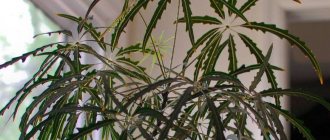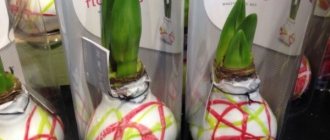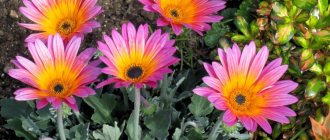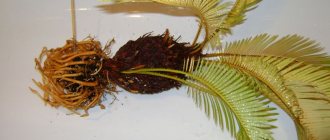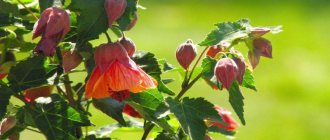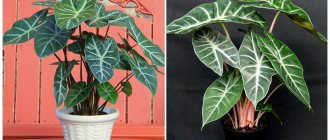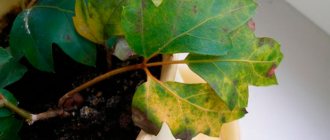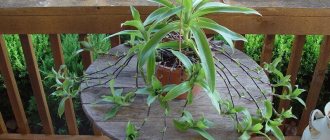The beautiful zamia came to us as if from a fairy tale: its amazing forms - from the roots to the very top - immediately attract attention and evoke thoughts of overseas countries inhabited by scaly dragons and majestic trees.
This plant is a real relic: it grew on the planet 200 million years ago, and, having survived all the cataclysms, has survived to this day. Translated from Latin, “zamia” means unprofitable, defective,” but what’s wrong with it? Let's find out.
Botanical description
Zamia is part of the Zamiaceae family, which, in turn, belongs to the cycad genus. This evergreen plant's trunk resembles a bottle - it is also rounded at the bottom, massive and covered with smooth bark.
The leaves look extremely impressive : they are glossy, leathery, feathery and grow in the shape of an oval. The edges can be either solid or jagged; they are divided at the base into 2 lobes: one narrow, the other wide. The veins on the plates change over time: at first they are pale green, but gradually acquire an olive tint. The stalk is most often smooth, but in some varieties it is covered with spines.
Zamia is a dioecious plant. Adult specimens have female leaves to which megastrobiles are attached, and male leaves to which microstrobilae are located.
Zamia pruning
Decorative palm trees are not trimmed due to uneven growth of leaf blades. In addition, the leaves grow slowly, which means pruning will have a negative impact on the plant.
Unlike other crops, zamia will not become more magnificent from the removal of branches, but, on the contrary, after the procedure it will begin to dry out and die. The most a grower can do is remove dead shoots if necessary.
Zamia and Zamiokulkas, what is the difference?
Zamioculcas (popularly called the “dollar tree”) received its name precisely because of its similarity with zamia. Their leaf plates are so similar. However, these plants are not relatives. Zamioculcas belongs to the aroid family, loves partial shade, and grows in rocky and dry areas. It has no stem, and what we see are leaves growing directly from the root.
Soil for zamia
Suitable soil for the plant should be of medium density and with a large amount of nutrients.
You can purchase a substrate for zamia at a flower shop, or you can make it yourself from leaf and turf soil, peat, humus and sand, taken in equal proportions.
At the bottom of the pot it is necessary to make drainage from fine expanded clay to prevent moisture from stagnating at the roots.
Varieties and their photos
In total there are approximately 60 species in the genus. A significant part grows in the tropical forests of North and South America. At home, only a few types of zamia can be provided with proper care.
Florida (Zamia floridana)
This is the only species that sheds all its foliage for the winter . And it didn’t grow tall: its maximum height is 30-35 cm. However, the stems are capable of stretching up to a meter in length. Each one grows at least 50 pairs of leaves, pointed and with jagged edges. The photo below shows Zamia Florida:
Powdered or rough (Zamia furfuracea)
In mature plants, the trunk protrudes slightly above the ground; in young plants, it is completely hidden. Another way to determine age is to look at where the plant's scales are located. In the old one they are only at the bottom of the leaves, in the young they are located over the entire surface. The stems are gray or bluish in color and bend to the ground, thereby forming a fluffy, rounded bush.
The length of the stems is 1-1.5 meters. The leaf blades are pinnate, elongated, no more than 20 cm in length (no more than 6 cm in width), leathery and dense, with distinct veins on the reverse side. 12-14 pairs grow on one stem.
The homeland of zamia rough is Mexico. You can see what the rough variety looks like in the photo below:
Dwarf (Zamia pygmaea)
The shortest variety. The height of the trunk is 20-25 cm. Like the others, it is completely immersed in the ground. The leaves are dark green, long, feathery, similar to palm trees. The photo below shows the dwarf variety:
Broadleaf (Zamia latifolia)
Grows in Cuba. The trunk is tuberous, completely hidden in the soil (only in very old plants it peeks out slightly on the surface). The stem is up to half a meter long, each with 12-16 pairs of leaves . This species is considered the most whimsical, often gets sick and takes root worse than others in captivity. The photo below shows Zamia latifolia:
General information
In nature, zamia grows in the tropics and subtropical parts of North and South America. Most varieties of the plant are distinguished by a smooth, pear-shaped trunk, which is hidden deep in the soil.
The leaf plates are located on the branches, framing them on both sides to the very top. They have an elliptical shape and are on a long petiole. Young leaves resemble a fern, dividing into two parts at the base.
In nature, the crop blooms in mid-summer, and after flowering, zamia forms fruits that look like hollow cones. However, the cultivated plant does not bloom or does so very rarely.
The culture is not whimsical in care, but at the same time it has a very impressive decorative appearance. Therefore, if a florist wants to add a mini palm tree to his flower collection, zamia will be an ideal option for him.
Care
Lighting
Zamia loves light and tolerates direct sunlight well. But this does not mean that in the thick of it you can leave it on the windowsill to the mercy of fate. It will feel good on the southern, western and eastern windows, but you should not place it on the northern one - the indoor plant will lose all its gloss and will not grow well. On a hot afternoon, cover it from the sun with thick curtains or a paper screen.
To ensure that the leaves grow evenly and the trunk does not become askew , turn it to the light on one side or the other every week. With the onset of warm days, you can take the zamia out to the loggia, balcony or garden.
It does not like temperature changes, and also does not like stagnant air in the room, so ventilate it more often. The plant is not afraid of drafts, but it is not worth keeping it under an open window in the winter.
Temperature
The optimal temperature range is from +25 to +28 degrees.
Such indicators should be maintained from March to November; the rest of the time the zamia rests, so the temperature should be reduced to +18. You can’t go lower – the plant will no longer be comfortable. Do not place a flower pot next to working heating devices , but if this happens, install a humidifier next to it.
Humidity and watering
You should water generously, but make sure that the top layer of soil is completely dry between waterings. In winter you will have to do this less often, in summer - more often.
The plant is undemanding to air humidity. Both at low and high levels, it grows and develops well. Therefore, spray the plant at your convenience. But it is necessary to wash dust from the leaves once a week. Soak a soft sponge or cotton cloth in clean water and gently wipe the leaf blades and stems. But this only applies to the waking period! In winter, when the zamia is “sleeping,” you should not disturb it again.
Experienced flower growers know very well how much depends on the quality of water. Hard, chlorinated tap water contains so many salts and harmful impurities that not a single plant, even the most unassuming one, can survive for long.
There is no need to talk about zamia: it will quickly begin to turn yellow, fade and, in the end, disappear. Remember: water should be at room temperature, purified, with a neutral pH level . Liquid that is too cold has a negative effect on the roots, as does hot liquid. All harmful compounds will also settle there. You can use rainwater for irrigation (but collected only during periods of prolonged and heavy rains), tap water (it should first be kept for a day in a jar without a lid so that chlorine and impurities evaporate) and passed through a household filter.
Top dressing
In both spring and summer (during the growing season), do not forget to feed zamia with complex fertilizers for indoor flowers (Ideal, Bona Forte, Etisso, Pokon or Agricola).
It is enough to do this once every 3 or even 4 weeks. You should not fertilize in autumn and winter.
Priming
Suitable soil for zamia is medium density and nutritious. At a gardening store you can buy universal soil or soil for decorative foliage plants. The plant will take root well in both conditions. The third option is to make the soil yourself . Mix humus, peat, river sand (coarse), turf and leaf soil in equal parts. A handful of charcoal will help reduce the risk of root rot. Fine expanded clay is suitable for drainage. Don’t forget to heat the finished mixture in the oven or steam it in a water bath!
Buy a pot for zamia that is clay and unglazed, deep, and in width slightly larger than the size of the root system. Such containers are quite durable, and at the same time allow the roots to “breathe” properly.
Transfer
Zamia tolerates transplants well, but they should be carried out only when necessary: if she is sick or the root system has become so crowded in the pot that the roots have begun to crawl out. Since the palm tree grows quickly, it needs to be replanted every year for the first 5 years, and then every 2-3 years. Do not move the old plant; it will be enough to change the top layer of soil.
Carry out the transplant using the transshipment method. It will take about a month for the zamia to get used to the new place, so place the pot in partial shade during this time and do not feed it.
Zamia juice contains a toxic substance cycasin , so do not allow pets and birds to taste the houseplant. Carry out all procedures with gloves.
Watering zamia
In spring and summer, zamia needs abundant watering. Watering should be done several times a week, immediately after the top layer of soil dries out. In autumn, the plant should be watered less, and in winter, soil moisture is reduced to a minimum.
Overmoistening or, conversely, drying out of the substrate in a pot with a plant can lead to slower growth or even death of the zamia.
Reproduction
Cuttings
- Cut a healthy cutting 10 cm long from the plant and keep it in the Epin or Kornevin solution for 2-3 hours.
- Once the roots appear, place the cuttings in a container with a mixture of sand and peat. A plastic container or cup will do. Cover it with a glass jar or polyethylene and place it in a warm and well-lit place. Ventilate every day and water as needed.
- As soon as the leaves appear, transplant them into a permanent pot.
Seeds
Propagation by seeds is more difficult, because it is almost impossible to obtain seed material under indoor growing conditions , and when buying in a store, there is a high risk of running into a low-quality product.
- Keep the seeds in a weak solution of potassium permanganate for a couple of hours.
- Plant in a mixture of peat and sand (deep).
- Place in a warm place, but not in direct sunlight. Temperature for growing – +25-30 degrees.
- Care is the same as for cuttings. When leaves appear, replant into pots.
Zamia flowering
Zamia blooms exclusively in the wild. The time of appearance of inflorescences occurs in mid-summer. After flowering, the plant forms cones with seeds, similar to those that appear on coniferous trees.
Cultivated zamia does not bloom, since at home it is almost impossible to create the tropical microclimate necessary for the plant to bloom.
Pests and diseases
The toxicity of the palm tree repels most of the pests known to us, but its poison does not frighten scale insects and spider mites. These insects can destroy your pet in a matter of weeks, so do not put things off, but, having discovered parasites, immediately get to work .
- Wrap the pot in plastic to prevent the soil from souring, and wash the zamia under a warm shower. This will help remove some of the pests.
- Wipe the leaves with a cotton swab dipped in soapy water or onion broth.
- Treat the plant with a suitable preparation: Fitoverm or Actellik will help against scale insects, and Agravertin will help against spider mites.
The spider mite, having taken a liking to the plant, begins to entwine it with cobwebs. Along the way, the insect gnaws through the leaves, causing them to become covered with white dots, which disrupts the process of photosynthesis. The flower dies, and the mite moves to another. Scale insects look like tiny spots on the underside of leaves. A sticky liquid is released in which a sooty fungus gradually develops.
- Why do zamia leaves turn yellow and fall off? You have placed the plant in full sun, move the pot to partial shade. Another possible reason is hypothermia or draft. The drugs “Orton Rost”, “Zircon”, “Epin” will help to cope with the problem.
- Root rotting occurs due to excess water or due to a large amount of nitrogen in the fertilizer.
- The appearance of brown spots on the leaves indicates a lack of nutrients.
If the process progresses, moving the pot will no longer help the matter. The plant is clearly affected by a fungal or infectious disease.
A set of measures will be needed: transplant the zamia into a new pot with fresh soil, treating the roots with Fitosporin along the way and removing the damaged parts. To prevent this situation from happening again in the future , keep the new flower in quarantine for a couple of weeks (away from other house plants), and then replace the store-bought soil with a new one.
Zamia transplant
During the first five years after planting, the plant should be replanted every year. In the future, transplantation will be carried out every three years. The procedure should be performed by transferring a clod of soil from an old pot to a new one.
However, before replanting, it is necessary to lay a drainage layer of fine expanded clay on the bottom of the new pot, then move the plant along with the soil into a new pot, filling the resulting voids with prepared soil and pouring a lump of it on top of the ground.
After this, the soil needs to be lightly pressed to compact it and watered. It will take about a month for the plant to acclimatize.
Photo gallery
natusik_ant
red_headed_flower
plantslana
shkolatsvetovodov
mygreenhome2823
Growing conditions for indoor zamia
This amazing plant is a native of tropical America, unpleasantly surprising with its capriciousness to temperatures and lighting. The humid, warm, but not bright undergrowth of the tropical jungle is not so easy to recreate in your home.
Lighting and placement
Zamias love bright lighting. At the very least, the room needs maximum light. The younger the plant, the more sensitive it is to deviations from the ideal regime. On a south window, direct sun can harm the plant only at midday; with a diffusing screen, southern and partially southern orientations remain the ideal placement option.
For zamia, lighting during the rest period should be increased as much as possible, preferably with additional lighting, but the key to success is the transition periods. If the weather is cloudy in spring, you need to take the same measures as in winter, otherwise you may “miss” the period of most active growth. And in the fall it is better not to delay with compensation measures.
It is necessary to rotate the plant. The ideal symmetry of zamia is only an appearance; the plant easily bends and produces new leaves towards the light source. And if you forget to move the pot regularly, it will be very difficult to achieve a decorative effect from the zamia.
